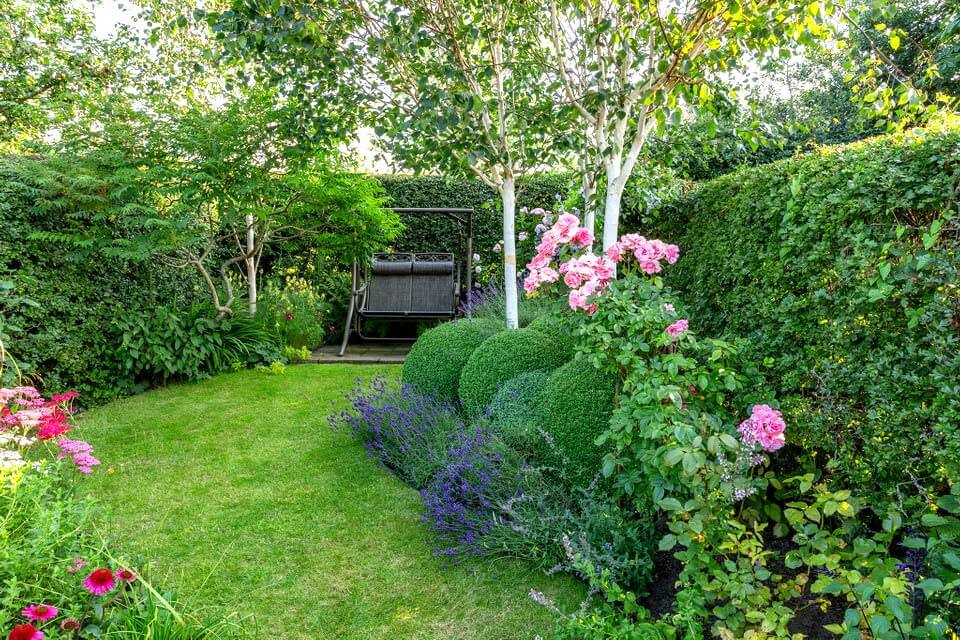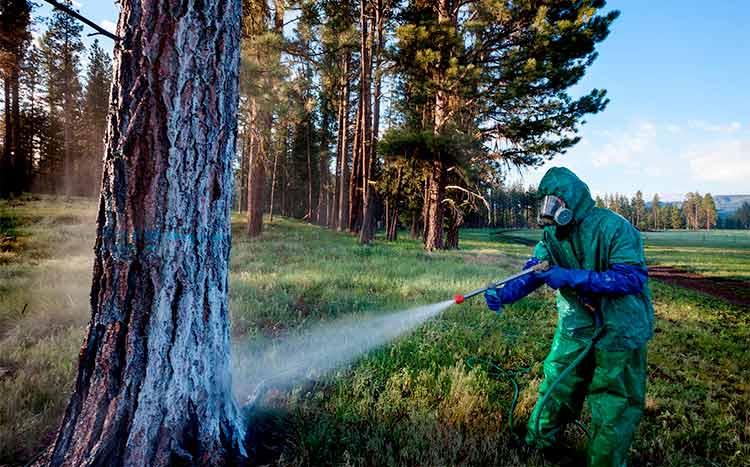Most people shy away from doing the basics to keep their trees and shrubs healthy. You will often hear excuses like, “I don’t have any luck with plants or I don’t have a green thumb to maintain a potted plant let alone a whole tree or garden shrub”. Well, let’s debunk that myth today with this simple and fun basic tree and shrub care guide.
Basic tree or shrub care involves simple everyday tasks like watering, checking for pests and diseases as well as long-term care like seasonal pruning, trimming, root collar excavation, adding fertilizer, getting rid of pests and weeds, etc. You can have a landscaping expert or arborist do the technical tasks while you handle the simpler everyday tasks as you learn.
What we cover
ToggleRegular maintenance tasks for trees and shrubs
Watering
Frequency: 1 – 2 times per week
Your shrubs or trees’ water needs will depend on the tree type and your local climate. Water more in summer and less in winter. Generally trees over 40 ft. will have tapped an underground water source, so probably no need to water. Only if they are showing signs of dehydration1. Water them at least once every week in summer and every other week in winter if you do not know their water needs.
Mulching and Fertilizers
Frequency: Yearly
Shrubs and trees need nutrients that may not be present in the soil. Use organic mulch for young shrubs or trees and fertilizer for mature or medium-aged ones to keep them green and nourished. Be sure to use the correct fertilizer for the species you are taking care of.
Seasonal Pruning vs scheduled Trimming
Frequency: Every 2 – 4 years
Seasonal pruning involves removing dead and dried-out branches and limbs. On the other hand, scheduled trimming involves cutting off healthy branches from trees or shrubs to shape the crown or reduce its density. These activities are best given to trained tree experts for the best results.

Other typical tree & shrub care tasks
Dead Wood Removal
Frequency: Every 3 – 4 years
Deadwood removal is an activity whose main aims are to improve the overall health of a tree or shrub, improve its appearance and make it safer. It involves cutting off dead, dry, or decaying branches and limbs. You can remove dead wood on small shrubs and young trees and have a professional take care of taller mature trees.
Pruning for Structural Integrity
Frequency: As needed
Pruning is closely related to deadwood removal but is done on a seasonal basis and is more complex. It involves selectively removing some branches, limbs, and leaves to improve the structural integrity of a tree or shrub.
Treating Pests and Disease
Frequency: As needed
Pests and diseases can wreak havoc on a well-maintained garden. Keep an eye out for signs of diseases or pests affecting your shrubs and treat them promptly. Find a trained “tree doctor” or arborist to test for diseases and pests and treat your garden plants before it is too late.
Root Pruning
Frequency: As needed
Root pruning is a delicate tree care activity only done when a tree is to be transplanted or if there is a need to give room for nearby construction. It involves cutting off some roots to minimize damage to the tree when it is transplanted or from nearby construction. Root pruning should be left to trained experts.
Shrub Removal
Frequency: As needed
There will be times when you have a shrub that dies, and there is nothing more you can do. In this case, you will need to remove the shrub using a local service or doing it yourself.
Tree and Shrub Care Cost
If you want to hire a professional arbor tree care company, Below is a price list of tasks you might need to perform on a bi-annual basis.
| Task | Price range |
|---|---|
| Remedial or structural prune | $438 - $1,200 |
| Dead wood removal | $250 - $650 |
| Tree risk assessment | $100 - $150 |
| Root pruning | $250 - $450 |
| Pest control and treatment | $150 - $550 |
| Fertilization | $80 - $150 |
Insecticide to Use for Trees
There are many good-quality insecticides from a myriad of manufacturers out there to choose from. Some are organic while others are made from synthetic chemicals.
Make sure you use the correct insecticide based on the type of pest and tree species you will be using it on or use a general-purpose spray.
Also, mind the environment when using insecticide on your trees2. Some of them may kill harmless or useful insects such as bees that help in pollination. If unsure, it’s always better to have a professional choose and apply the insecticides for you.

Insect Control
Tree and shrub insect control involves spraying or applying insect repellents and killers to get rid of unwanted and destructive insects such as termites. Special chemical sprays or formulations that are harmless to other insects such as bees should be used.
| Disease | Trees/ Parts affected | Severity | Treatments |
|---|---|---|---|
| Anthracnose Disease | Leaves | Severe-destroys leaves | Trimming, proper tree spacing, fungicides |
| Apple Scan Disease | Crabapple trees/ leaves and fruits | Severe- destroys leaves and causes rotting | Fenarimol fungicide |
| Cedar Rusts Disease | Rosaceous plants | Mild | Fungicide |
| Cypress Canker | Cypress/ Bark | Severe | Trimming |
| Oak Wilt | Oak Trees | Mild | Fungicides, preventive care |
| Diplopia Tip Blight | stressed conifers | Mild | Fungicides |
| Fire Blight | Fruit Trees | Severe | Pruning and disinfection |
| Powdery Mildew | crape myrtle | Mild | Fungicides |
Poor maintenance behavior to avoid
- Deep mulching
Avoid adding excessive mulch deep in the soil around the roots. Deep mulching3 can have the opposite effect from the intended one by damaging the roots of an otherwise healthy tree. This is because excessive mulch reduces soil aeration around the roots and makes it harder for the plant to break down and absorb nutrients. - Insufficient watering
Insufficient watering denies the tree the fluids it needs to survive, especially in hot climates or dry areas. Ensure the ground around your tree base is properly watered at all times. Create a regular watering schedule for your trees. - Girdling Roots
Girdling roots usually from the soil emerge and may cut into parts of the lower trunk. These roots restrict the absorption of water and nutrients which can affect the health of a tree. Avoid planting your trees or shrubs too deeply to prevent girdling of roots.
Things you’ll need an arborist for
There are several methods you can use to protect your trees from diseases and pests. I suggest you call a certified arborist before attempting any of the following:
- Wound dressing
- Insect control
- Reduce nesting habitats
- Pruning diseased branches
- Using insect and animal repellents
- Building fences to prevent damage from large animals such as deer
- Trimming
- Tree cabling
Root Zone Fertilization
Root zone fertilization is a tree fertilization method that involves injecting a mixture of water and fertilizer using a high-pressure pump into the soil surrounding the root. This method ensures the fertilizer and water is directed to the roots and spreads evenly below the surface. Root zone fertilization can be done as frequently as needed to promote tree health and growth.
Why Care for Trees and Shrubs?
Your trees need proper care to stay healthy and continue growing. If you do not do some of the basics, you may lose some of them or have to spend a lot of money on treatment and restoration later. Some species need more frequent maintenance than others.
As an example, young trees and shrubs can dry out or remain dormant for months or years depending on the species if they are not watered or receive the nutrients they need to develop new branches and leaves. Other trees e.g. Oaks are susceptible to pests and diseases especially in the hot summer months.
Who to Call for Diseased Trees?
The best person to contact if you have a diseased tree or shrub is an arborist. Arborists are trained tree experts that can diagnose the disease affecting your tree or shrub and come up with the appropriate treatment or restoration plan. They can also generate a report to be used for future care and other purposes.
Tip: Finding local tree experts like arborists can be a daunting task for most people. To make it easier for you, we have developed a free search tool that links you up with vetted and top-rated tree care experts near you.
To use the free tool, just scroll to the top of the page and enter your zip code to search. You will also receive free quotes from recommended experts near you that you can hire at your pleasure.
- Davey Tree Expert, (2022) Signs of Underwatering Trees or Overwatering Trees. <https://blog.davey.com/signs-of-underwatering-trees-or-overwatering-trees/> Accessed: 19-03-2024
- John A. Chmiel, Brendan A. Daisley, Andrew P. Pitek, Graham J. Thompson, Gregor Reid, (2020) Understanding the Effects of Sublethal Pesticide Exposure. <https://www.frontiersin.org/journals/ecology-and-evolution/articles/10.3389/fevo.2020.00022/full> Accessed: 19-03-2024
- David R. Jackson, (2018) Mulching Landscape Trees. <https://extension.psu.edu/mulching-landscape-trees> Accessed: 19-03-2024














